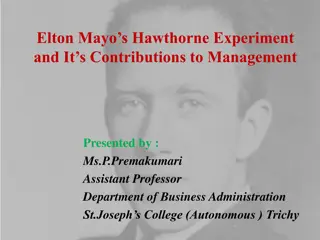
George Elton Mayo - Father of Human Relations Approach & Hawthorne Experiments
George Elton Mayo, the pioneer of the Human Relations Approach and the Hawthorne Experiments, conducted research on factors affecting productivity in the workplace. His studies revealed the importance of psychological factors such as recognition and participation in enhancing productivity. Explore the illuminating experiments and conclusions drawn from the Relay Assembly Test Room study. Discover how Mayo's work revolutionized management practices by focusing on employee well-being and motivation.
Download Presentation

Please find below an Image/Link to download the presentation.
The content on the website is provided AS IS for your information and personal use only. It may not be sold, licensed, or shared on other websites without obtaining consent from the author. If you encounter any issues during the download, it is possible that the publisher has removed the file from their server.
You are allowed to download the files provided on this website for personal or commercial use, subject to the condition that they are used lawfully. All files are the property of their respective owners.
The content on the website is provided AS IS for your information and personal use only. It may not be sold, licensed, or shared on other websites without obtaining consent from the author.
E N D
Presentation Transcript
GEORGE ELTON MAYO HS 300 MODULE 2 Prof. Baiju B.S HOD, Dept. of Applied Sciences MEA Engineering College bsbaiju@gmail.com
GEORGE ELTON MAYO (1880-1949)
GEORGE ELTON MAYO Born in South Australia on, 26 December 1880 Father of Human Relations Approach Hawthorne Experiments (1924-1927)
HAWTHORNE EXPERIMENT 1. Illumination 2. Relay Assembly Test Room 3. Mass Interview Programme. 4. Bank Wiring Test Room
ILLUMINATION EXPERIMENT: This relationship between output and illumination. When the intensity of light was increased, the output also increased. But the output showed an upward trend even when the illumination was gradually brought down to the normal level. experiment was conducted to establish 1. 2.
CONCLUSION: It was concluded that there is no consistent relationship between output of workers and illumination in the factory. There must be some other factor which affected productivity.
RELAY ASSEMBLY TEST ROOM EXPERIMENT This phase aimed at knowing the impact of illumination and other factors on production, such as length of the working days, rest hours, physical conditions etc A small homogeneous work-group of six girls was selected.
RELAY ASSEMBLY TEST ROOM EXPERIMENT These girls were friendly to each other and were asked to work in a very informal atmosphere under the supervision of a researcher. Productivity and considerably during experiment. Productivity went stabilized at a high level. morale the increased of period the on increasing and
CONCLUSION The psychological factors such as feeling of being important, recognition, participation, resulted in higher productivity. researchers concluded that socio- attention and
MASS INTERVIEW PROGRAM The researchers interviewed a large number of workers with regard to their opinions on work, working conditions and supervision. Initially, a direct approach was used whereby interviewers asked important by managers and researchers. questions considered Later , this approach was replaced by an indirect technique. Where the interviewer simply listened to what the workmen had to say.
CONCLUSION The findings confirmed the importance of social factors at work in the total work environment.
. BANK WIRING TEST ROOM EXPERIMENT The experiment was conducted to study a group of 14 workers under conditions which were as close as possible to normal. After the experiment, the production records of the group were compared with their earlier records.
BANK WIRING TEST ROOM EXPERIMENT It was observed that the group evolved its own production norms for each individual worker, which was made lower than those set by the management. Because of this, workers produced only that much, thereby defeating the incentive system. Those workers who tried to produce more than the group norms were isolated, harassed or punished by the group.
CONCLUSION: Each individual was restricting output. The group had its own unofficial standards of performance. Individual output remained fairly constant over a period of time. Informal groups play an important role in the working of an organization.
CONCLUSION: Fear of unemployment: the basic reasoning of workers was that if there would be more production per head, some of the workers would be put out of employment . Fear of raising the standards: most workers were convinced that once they had reached the standard rate of production, management would raise the standard of production reasoning that it must be easy to attain.
CONCLUSION: Protection of slower workers: The workers were friendly on the job as well as off the job. They appreciated the fact that they had family responsibility that required them to remain in the job. Since slower workers were likely to be retrenched, the faster workers protected them by not overproducing. Satisfaction on the part of management: According to workers, management seemed to accept the lower production rate as no one was being fired or even reprimanded for restricted output.
HUMAN RELATIONS APPROACH 1. Human Relations Approach: Mayo is called the father of human relations movement. Human beings are complex and influential input into organisational performance. The social and psychological needs of human beings cannot be ignored. 2. Non-Economic Awards: The techniques of economic incentives were not only inadequate but also unrealistic.Humane and respectful treatment, sense of participation and belonging, recognition, morale, human pride and social interaction are sometimes more important than pure monetary rewards. 3. Social Man: man is basically motivated by social needs and obtains his sense of identity through relationships with others. 4. Organization as a Social System: An organization is a social system, a system of cliques, grapevines, informal status systems, rituals and a minute of logical, non-logical and illogical behavior.
HUMAN RELATIONS APPROACH - FEATURES A Manager must have a basic understanding of human behavior in all respects particularly in the context of work groups and organizations. A manager must study the inter-personal relations among the people at work. Larger production and higher motivation can be achieved only through good human relation. The study of management must draw the concepts and principles of various behavioral sciences like Psychology and Sociology.





















